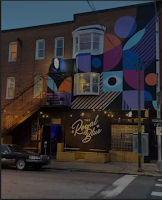DC Public Library
I was first made aware of the MICA/DC Public Library Curatorial
Fellowship program when the fellows came and did a tour of our exhibition
Land/Trust in the spring and presented their proposals to us. I was intrigued
by the overarching curatorial theme of these projects—the 50th anniversary
of the events of 1968.
The DC Public Library is reexamining the legacy of the tumultuous
year through arts programming, exhibitions, activism, and education. My role as
Curatorial Fellowship Intern has involved assisting in the planning and documenting of these
exhibitions and events, working in the historical archives, developing
editorial and social media content, running workshops, working with the
artist-in-residence, and with the librarians and to develop their own
curatorial practices. My professional goal is to do curatorial work focused on
the intersection of contemporary art with vernacular design and visual culture,
popular music, DIY media, history, and activism. The aspect of 1968 that we
have been looking at specifically, the Poor People’s Campaign, has
intersections of all of these topics. My direct supervisor was Natalie Campbell
who works as Exhibitions and Planning Consultant for the DCPL.
The Poor People’s Campaign—the project that Dr. Martin Luther
King, Jr., was planning at the time of his assassination—was a multi-ethnic
coalition that from the beginning had art, music, and design integrated into
its strategy. The great Resurrection City that the campaign built and occupied
for nearly 40 days was designed in collaboration with John Wiebenson, professor
of architecture at the University of Maryland, College Park, and a team of
designers. The house structures they created are fine examples of highly
modifiable, modern modular design. Poster design, graffitti, and participatory
mural painting were also key visual strategies of Resurrection City. The City’s
Many Races Soul Center served as an important meeting hall for religious services,
workshops, and perhaps most importantly, singalongs and concerts featuring
music from the many groups who came to DC in solidarity—Black Gospel,
Appalachian Folk and Bluegrass, Latin American music styles, and American
Indian songs. Aretha Franklin; Pete Seeger; Elizabeth Cotten; Dick Gregory;
Peter, Paul & Mary; and Roberta Flack all made appearances at the Soul
Tent. Much of this content was recorded but never released—and we were lucky
enough to be able to utilize it in our exhibition. The New Poor People’s
Campaign, which aims to reignite the original movement’s “national call for
moral revival,” adds DIY media to this strategy, empowering participants to
tell their own stories. In this way this project is a perfect fit with my
professional goals.
A moment I am particularly proud of, is when we integrated our
nomadic Soul Tent exhibition into the New Poor People’s Campaign rally in DC—adding
depth to both our project and their rally. My biggest take away is that
libraries are both very powerful curatorial platforms and can be large unruly
organizations.





